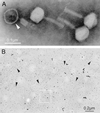Discovery, purification, and characterization of a temperate transducing bacteriophage for Bordetella avium
- PMID: 11029434
- PMCID: PMC94748
- DOI: 10.1128/JB.182.21.6130-6136.2000
Discovery, purification, and characterization of a temperate transducing bacteriophage for Bordetella avium
Abstract
We discovered and characterized a temperate transducing bacteriophage (Ba1) for the avian respiratory pathogen Bordetella avium. Ba1 was initially identified along with one other phage (Ba2) following screening of four strains of B. avium for lysogeny. Of the two phage, only Ba1 showed the ability to transduce via an allelic replacement mechanism and was studied further. With regard to host range, Ba1 grew on six of nine clinical isolates of B. avium but failed to grow on any tested strains of Bordetella bronchiseptica, Bordetella hinzii, Bordetella pertussis, or Bordetella parapertussis. Ba1 was purified by CsCl gradient centrifugation and was found to have an icosahedral head that contained a linear genome of approximately 46.5 kb (contour length) of double-stranded DNA and a contractile, sheathed tail. Ba1 readily lysogenized our laboratory B. avium strain (197N), and the prophage state was stable for at least 25 generations in the absence of external infection. DNA hybridization studies indicated the prophage was integrated at a preferred site on both the host and phage replicons. Ba1 transduced five distinctly different insertion mutations, suggesting that transduction was generalized. Transduction frequencies ranged from approximately 2 x 10(-7) to 1 x 10(-8) transductants/PFU depending upon the marker being transduced. UV irradiation of transducing lysates markedly improved transduction frequency and reduced the number of transductants that were lysogenized during the transduction process. Ba1 may prove to be a useful genetic tool for studying B. avium virulence factors.
Figures




References
-
- Ackerman H W, Berthiaume L, Jones L A. New actinophage species. Intervirology. 1985;23:121–130. - PubMed
-
- Barksdale L, Arden S B. Persisting bacteriophage infections, lysogeny and phage conversions. Annu Rev Microbiol. 1974;28:265–299. - PubMed
-
- Barondess J T, Beckwith J. A bacteriophage virulence determinant encoded by lysogenic coli phage lambda. Nature. 1990;346:871–874. - PubMed
-
- Betley M J, Mekalanos J J. Staphylococcal enterotoxin F1 is encoded by phage. Science. 1985;229:185–187. - PubMed
Publication types
MeSH terms
Substances
Grants and funding
LinkOut - more resources
Full Text Sources
Molecular Biology Databases

